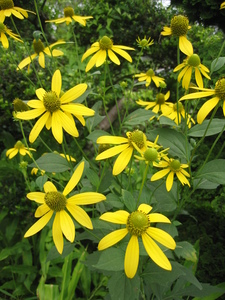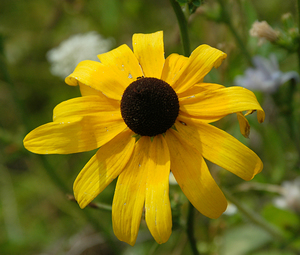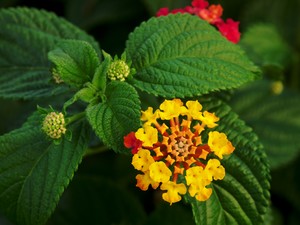Permaculture companion plants for Rio Grande Globe Amaranth
Back to Rio Grande Globe Amaranth
| Image | Name | Data | Description | Actions |
|---|---|---|---|---|

|
Cone Flower |
3-7
Perennial
Full sun, Partial sun/shade
Moist
Light (sandy), Medium, Heavy (clay)
2.4
true
Stem
https://en.wikipedia.org/wiki/Rudbeckia_laciniata
Medium
Cutleaf coneflower, green headed coneflower
Asteraceae or compositae
https://pfaf.org/User/Plant.aspx?LatinName=Rudbeckia laciniata
Alabama, Arizona, Arkansas, British Columbia, Colorado, Connecticut, Delaware, Florida, Georgia, Illinois, Indiana, Iowa, Kansas, Kentucky, Louisiana, Maine, Manitoba, Maryland, Massachusetts, Michigan, Minnesota, Missouri, Montana, Nebraska, New Brunswick, New Hampshire, New Mexico, New York, North Carolina, North Dakota, Nova Scotia, Ohio, Oklahoma, Ontario, Pennsylvania, Prince Edward I., Québec, South Carolina, South Dakota, Tennessee, Texas, Vermont, Virginia, West Virginia, Wisconsin, Wyoming
Altay, Austria, Baltic States, Belarus, Belgium, Bolivia, Bulgaria, Colombia, Czechoslovakia, East European Russia, Fiji, Finland, France, Germany, Great Britain, Hungary, Italy, Japan, Jawa, Kazakhstan, Korea, Krym, Kuril Is., Netherlands, Norway, Pakistan, Poland, Primorye, Romania, Sakhalin, South European Russi, Sweden, Switzerland, Tadzhikistan, Taiwan, Turkmenistan, Ukraine, Uzbekistan, Yugoslavia
https://powo.science.kew.org/taxon/urn:lsid:ipni.org:names:241716-1
Dye
|
Cone flower, or Rudbeckia laciniata, is a species of flowering plant native to the central and eastern United States. It typically grows to about 2-4 feet tall, with a spread of about 1-2 feet. The plant has a clumping habit, with upright stems and large, daisy-like flowers. The flowers have yellow petals and a dark brown or black central cone. The leaves are lance-shaped and toothed, and are arranged in a basal rosette. In terms of growing conditions, cone flower prefers well-drained soil and full sun to partial shade. It is generally easy to grow and is tolerant of a range of soil types. It is also drought-tolerant once established. To cultivate the plant successfully, a grower would need to plant it in a location that receives plenty of sunlight and water it regularly until it is established. Once established, the plant can be allowed to dry out somewhat between watering. Cone flower is winter hardy and can survive cold temperatures. It is also attractive to a range of pollinators, including bees and butterflies. The plant is not edible and does not have any known medicinal uses. However, it can be used in ornamental gardens and as part of natural landscaping. Its showy flowers and attractive foliage make it a popular choice for gardeners. |
Show
Edit |

|
Black Eyed Susan |
4-9
Biennial, Perennial
Full sun, Partial sun/shade
Moist
Light (sandy), Medium, Heavy (clay)
04-0.9m
https://en.wikipedia.org/wiki/Rudbeckia_hirta
Medium
Coneflower, Gloriosa Daisy, Marguerite Jaune
Asteraceae or Compositae
Weed potential
https://pfaf.org/User/Plant.aspx?LatinName=Rudbeckia hirta
Roots
6.8-7.7
Alabama, Alberta, Arkansas, British Columbia, California, Colorado, Connecticut, Delaware, District of Columbia, Florida, Georgia, Idaho, Illinois, Indiana, Iowa, Kansas, Kentucky, Louisiana, Maine, Manitoba, Maryland, Massachusetts, Michigan, Minnesota, Mississippi, Missouri, Nebraska, New Brunswick, New Hampshire, New Jersey, New Mexico, New York, North Carolina, North Dakota, Nova Scotia, Ohio, Oklahoma, Ontario, Oregon, Pennsylvania, Prince Edward I., Québec, Rhode I., Saskatchewan, South Carolina, South Dakota, Tennessee, Texas, Utah, Vermont, Virginia, Washington, West Virginia, Wisconsin, Wyoming
Austria, Baltic States, Belarus, Belgium, Cuba, Czechoslovakia, East European Russia, France, Germany, Great Britain, Hungary, Ireland, Irkutsk, Italy, Japan, Kazakhstan, Kirgizstan, Korea, Krym, Kuril Is., Myanmar, Netherlands, Newfoundland, Norway, Poland, Primorye, Romania, South European Russi, Spain, Sweden, Switzerland, Turkmenistan, Ukraine, Uzbekistan, West Siberia, Yugoslavia
https://powo.science.kew.org/taxon/urn:lsid:ipni.org:names:223740-2
|
Black Eyed Susan (Rudbeckia hirta) is a flowering plant native to North America. It has a sturdy stem and can grow up to 2-3 feet tall. The leaves are green and lance-shaped, and the plant produces bright yellow or orange flowers with a dark center. The flowers bloom from mid to late summer. Black Eyed Susan prefers well-drained, moist soil and full sun to partial shade. It is a hardy plant and can tolerate a wide range of growing conditions. To cultivate it successfully, make sure the soil is adequately moist and provide sufficient sunlight. Black Eyed Susan is not known to be edible, but the plant has a number of uses. It is often grown for its attractive flowers, which can be used in bouquets and other floral arrangements. The plant is also beneficial for wildlife, providing food and shelter for a variety of animals. It is also known to have medicinal properties and has been used to treat a variety of ailments. |
Show
Edit |

|
Wild Sage |
https://en.wikipedia.org/wiki/Lantana_camara
true
Fast
Dry, Moist, Wet
Full sun, Partial sun/shade
8-12
Shrubs
Lantana verbena, shrub sage, yellow sage, abelwinyo, aruppu, dieng-sohpang-khlieh, galphusia, ghaneri, imomwa-ajele, jerenga, jhurmuta, kamkung, latina, magwagwa, masino kanda, maviamkuku, mbarapati, mjasasa, mshomoro, mushomoro, pakakrong, red sage bush, tantani, tek-tagwari, ubuhobe besukhiwa, uni, wild sage, yeregna genfo, aripple, bahama tea, bandera española, caburá caá, camará, camará de dos colores, cambara, cambará, chumbinho, cinco negritos, english sage bush, hierba de cristo, lantana, lantanier, largeleaf lantana, masino kanda, polung, qi jie mei, red sage bush, shrub verbena|gandapana / rata hinguru, siete negritos, sitaji phul, sudu gandapana, thangbua, utywala bentaka, west indian lantana, wild sage, wood sage, yellow sage, yerba de la cruz
Light (sandy), Medium, Heavy (clay)
Verbenaceae
1.8
Fruit, Leaves
Weed potential
https://pfaf.org/User/Plant.aspx?LatinName=Lantana camara
Belize, Colombia, Costa Rica, Cuba, El Salvador, Guatemala, Mexico Central, Mexico Gulf, Mexico Northeast, Mexico Northwest, Mexico Southeast, Mexico Southwest, Nicaragua, Panamá, Puerto Rico, Venezuela
https://powo.science.kew.org/taxon/urn:lsid:ipni.org:names:77129074-1
Tea
Biomass, Essential Oil, Fencing, Animal feed, Fire starter, antifungal, Hedgerow, Herbicide, Houseplant, Pest control, Mulch, textiles, Erosion control, Teeth, Ground cover, Fragrance
|
Show
Edit |